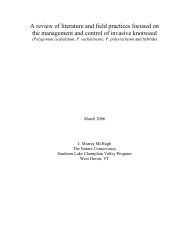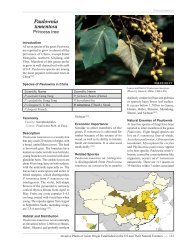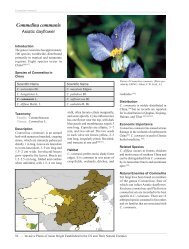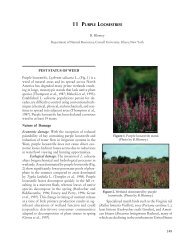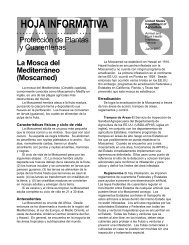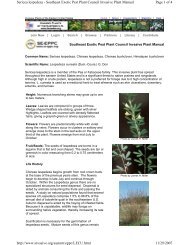Steps for the dissection of male Spodoptera moths and notes on ...
Steps for the dissection of male Spodoptera moths and notes on ...
Steps for the dissection of male Spodoptera moths and notes on ...
Create successful ePaper yourself
Turn your PDF publications into a flip-book with our unique Google optimized e-Paper software.
3. Examining <str<strong>on</strong>g>the</str<strong>on</strong>g> coremata (an external structure), opti<strong>on</strong>al. With <str<strong>on</strong>g>the</str<strong>on</strong>g> left<br />
straight <str<strong>on</strong>g>for</str<strong>on</strong>g>ceps hold <str<strong>on</strong>g>the</str<strong>on</strong>g> genitalia, <str<strong>on</strong>g>and</str<strong>on</strong>g> with <str<strong>on</strong>g>the</str<strong>on</strong>g> back <str<strong>on</strong>g>of</str<strong>on</strong>g> curved-tipped <str<strong>on</strong>g>for</str<strong>on</strong>g>ceps<br />
or using a brush remove some <str<strong>on</strong>g>of</str<strong>on</strong>g> <str<strong>on</strong>g>the</str<strong>on</strong>g> hairs <strong>on</strong> <str<strong>on</strong>g>the</str<strong>on</strong>g> outside <str<strong>on</strong>g>of</str<strong>on</strong>g> <str<strong>on</strong>g>the</str<strong>on</strong>g> valve to<br />
examine <str<strong>on</strong>g>the</str<strong>on</strong>g> coremata (=membranous lobes). Pull gently <strong>on</strong> <str<strong>on</strong>g>the</str<strong>on</strong>g> bottom <str<strong>on</strong>g>and</str<strong>on</strong>g><br />
<str<strong>on</strong>g>the</str<strong>on</strong>g>n <strong>on</strong> <str<strong>on</strong>g>the</str<strong>on</strong>g> top <str<strong>on</strong>g>of</str<strong>on</strong>g> <str<strong>on</strong>g>the</str<strong>on</strong>g> coremata to see if it has <strong>on</strong>e or two lobes. If it <strong>on</strong>ly<br />
has <strong>on</strong>e lobe, <str<strong>on</strong>g>the</str<strong>on</strong>g> specimen is nei<str<strong>on</strong>g>the</str<strong>on</strong>g>r S. litura nor S. littoralis. You may skip<br />
this step, but it is useful during screening.<br />
Coremata with<br />
two lobes<br />
<str<strong>on</strong>g>Spodoptera</str<strong>on</strong>g> litura<br />
4. Opening <str<strong>on</strong>g>the</str<strong>on</strong>g> valves. Grasp each valve <strong>on</strong> its side with <str<strong>on</strong>g>for</str<strong>on</strong>g>ceps <str<strong>on</strong>g>and</str<strong>on</strong>g> gently<br />
open <str<strong>on</strong>g>the</str<strong>on</strong>g>m, tugging a little so that <str<strong>on</strong>g>the</str<strong>on</strong>g>y stay open. It may be helpful to<br />
remove entirely <strong>on</strong>e valve so that it lies <strong>on</strong> its back without having to hold<br />
<str<strong>on</strong>g>the</str<strong>on</strong>g> o<str<strong>on</strong>g>the</str<strong>on</strong>g>r valve open.<br />
<str<strong>on</strong>g>Spodoptera</str<strong>on</strong>g> dolichos<br />
4


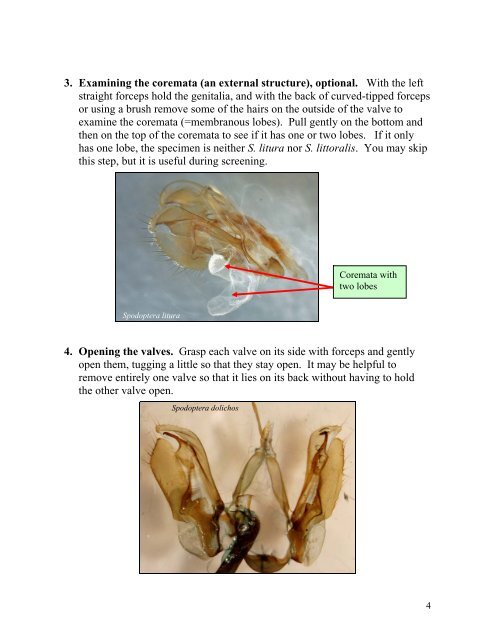

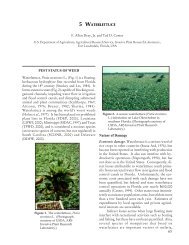

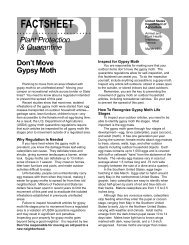
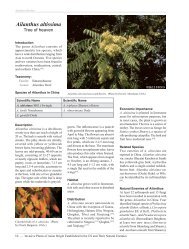
![A Guide to the Control and Management of Invasive Phragmites [PDF]](https://img.yumpu.com/27321025/1/190x190/a-guide-to-the-control-and-management-of-invasive-phragmites-pdf.jpg?quality=85)

